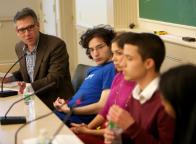When Andy Warhol exhibited his collection of 32 canvases of the now-iconic silkscreened Campbell’s Soup cans, he introduced a new wave of artistic expression in the form of repurposing already existing material. With the advent of the Internet, along with the construction and reconstruction of copyright law and the fair use doctrine, the line between artistic expression and copyright infringement has blurred. Include the culturally imbedded issues of piracy and free access, and this line is now completely destroyed, often creating more questions than answers.
Moderated by Professor Christopher Sprigman and LAMP co-founder Katherine Fry, Ph.D., a panel ranging from high school and college students to copyright and intellectual property experts—including Amanda Levendowski ’14 and Professor Jeanne Fromer—gathered on October 29 to discuss copyright law and fair use from the perspective of young people, educators, and creative individuals. Levendowski experienced the complications of copyright and fair use in an endeavor from her NYU undergraduate days, the Redactive Poetry Project, which allows users of her website to take words from the Internet and redact them to create original poetry.
“Students are worried about the academic implications of being caught plagiarizing, but when you’re online, it’s really tough for youths to figure out what plagiarism really means,” Levendowski said. “It’s very difficult to figure out what’s fair, what’s not fair, how to credit and source information in an academically responsible way, how to even figure out who the information belongs to.”
The topic shifted from copyright and plagiarism to copyright and fair use, which Neil Kosslyn, a junior at the Gallatin School of Individualized Study, found exceptionally important. As president of the now-defunct Free Culture Club, based on the book Free Culture by Lawrence Lessig, Kosslyn is appalled at art students’ lack of knowledge about copyright and fair use.
“‘Fair use and copyright are for other people’…. No one even knew how long copyright lasted for anymore,” Kosslyn said of other students he spoke with about their knowledge of copyright law. “We grew up with DRM and the RIAA.” Both DRM (Digital Rights Management) and RIAA (Recording Industry Association of America) serve as a way to control the copying and sharing of copyrighted material. “There isn’t really a strong press for change, because there isn’t really a sense that things were ever anything other than this way.”
Miguel Diaz, a senior at Mott Haven Village Preparatory High School, and Elisa Sterling-Smith, a prelaw student at Brooklyn College, also expressed their own concerns and experiences regarding copyright and fair use. “We were able to learn exactly what fair use was and how we as students, as educators, as parents, as teachers have certain rights,” Sterling-Smith said, “and the importance of those rights and maintaining and upholding them.”
Posted on November 7, 2013
